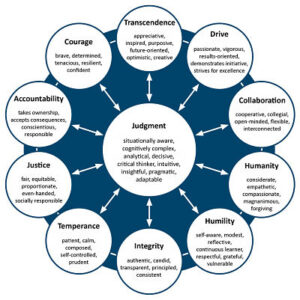Leadership & Courage
Leadership & Courage
Our recently released Leadership Character Insight Assessment (LCIA) defines and measures leadership character. The LCIA measures 11 dimensions of character, each of which breaks down into specific elements that can be observed as situationally appropriate behaviors (see Figure 1). Last time, we focused on Judgment. Today, we move to Courage.

Figure 1: LCIA dimensions and elements
What is Courage?
In the LCIA, we define courage as:
- Doing the right thing even though it may be unpopular, actively discouraged, and/or result in a negative outcome for him/her.
- Showing an unrelenting determination, confidence, and perseverance in confronting difficult situations.
- Rebounding quickly from setbacks.
Courage is critical to support other dimensions
Courage is a key enabler of the forward momentum required to achieve the sense of purpose and optimism associated with Transcendence. There are many challenges that arise with exercising Integrity, Justice, and Temperance. Courage is essential to overcoming these obstacles and challenges. To open yourself to the empathy and compassion associated with Humanity requires Courage and, in particular, the resilience associated with it. This is because Humanity may bring with it feelings of pain, suffering, and discontent.
Courage is further defined into the following 5 key elements:
- Brave: Does what one believes to be right even in the face of adversity. Stands up for personal beliefs and values. Stands up for others.
- Determined: Displays resolve and stays committed to see things through.
- Tenacious: Finishes things despite obstacles, difficulties, or discouragements along the way. Works hard over extended periods and follows through to achieve goals.
- Resilient: Endures and withstands difficult conditions. Recovers quickly from setbacks.
- Confident: Demonstrates self-assurance in his or her abilities, decisions, and actions.
Courage in Leadership: From the battlefield to the boardroom
In his article for the Ivey Business Journal, Peter Voyer draws on his experience in the Canadian Military and outlines how his leaders demonstrated “courage and in doing so, motivated and lead their subordinates through the dangerous Afghan landscape”. To be successful in this environment a leader needed to:
- Lead from the front
- Possess and demonstrate the moral fiber that facilitates courage
- Act quickly and decisively when faced with moral issues
- Actively ensure that dignity and respect are maintained in environments where substantial linguistic and cultural barriers exist between soldiers and the local population.
While the stakes may not be as high in your corporate environment, courage is no less critical for motivating and supporting your staff.
Voyer continues,
“Leadership (and its key constituent – courage) is not something to simply bring forward to exercise at opportune times. It must be practiced day in and day out. Courage is the centerpiece of leadership, and commonly and rightly, it is understood to be a critical component of success in military operations. Yet courage must prevail and be exercised in the corporate realm, where it is also critical. As we know, courage is not only a necessary core component of effective leadership. It is the platform – the requisite platform – on which other important tenets of leadership are built.”
Click here for more info on the LCIA.
